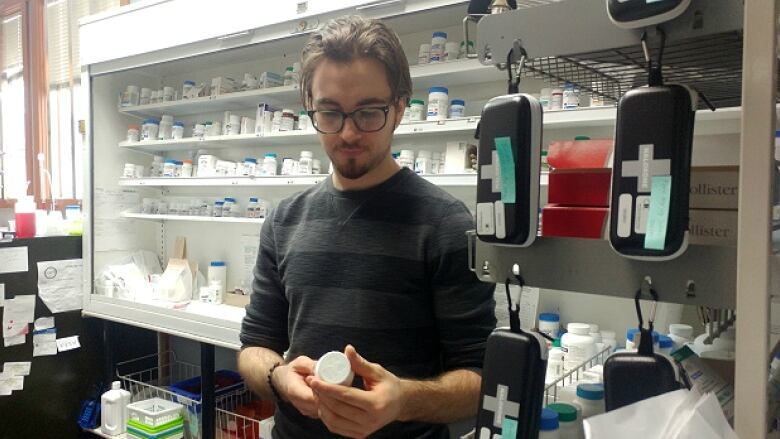Victoria pharmacy finds fentanyl in 90% of street drugs tested
Victoria pharmacy, researchers team up to improve fentanyl testing

What's really in that fake Oxycontin pill or rock of crack cocaine?
For street drug users, there's no way to know for certainbefore taking what could be a lethal dose of fentanyl orstronger substances.
A Victoria pharmacy that provides free testingof street drugshas found more than 90 per cent of the dozens of samples it has tested contain some amount of fentanyl.
JarredAasen, a pharmacist at the STS Pain Pharmacy in Victoria, said the current test uses a paper strip that reacts to the presence offentanylwhen it's dissolved in water.
- Winnipeg pharmacy to stock $5 kit to test for fentanyl in street drugs
- Drug testing by mass spectrometer difficult for non-experts to use, says former RCMP officer
"The main limitation is it doesn't quantify how muchfentanyl'spresent, so it can simply tell you"yes"or "no"if it's there,"Aasensaid.
That information is more useful for casual drug users than for those who are already severely addicted, he said."So, the next step would be to find a test that is quantifiable."
Forensic labs, including the RCMP,use a mass spectrometer tonot only identify the drugbut also tell how much drug is present.
That technology has been unavailable topharmacies and other harm-reduction services.
But inthe next couple of months, the STS Pain Pharmacy willbegin testinga prototype deviceto identifythe chemicals and their concentrations in drug samples.

Associate professor Dennis Horeof the University of Victoria chemistry departmentdeveloped thecompact, low-cost version of a spectrometer for drug analysis.
Hore said by turning over the prototype to the pharmacists, researchers will be able to see how it will be used outside the laboratoryand help create a library of data about the chemical contents of street drugs.
Many hurdles, including legal ones, remain before such a device could become more widely available, if it is successful.
'Fingerprinting' drug contents
"Those guys encounter a lot of different samples in their work, so it will be great for them to be able to 'fingerprint' them," Horesaid.
Hore said pharmacy owner Alain Vincent contacted him "out of the blue" about hisinterest in a device that could analyze street drugs.

They were able to receive funding to develop the device through a federal partnership program that pairs academics and industry.
Aasen said thenew device could directly help many of the pharmacy's clients with addictions.
"At the individual level, the user could get some good information to see what's in it and make some informed decisions as opposed to injecting a relatively unknown substance and seeing what happens," he said.
If it eventually becomes available in other pharmacies or harm reduction services, he said,it could reveal patterns and trends through the cloud of data that is created.












_(720p).jpg)


 OFFICIAL HD MUSIC VIDEO.jpg)
.jpg)



























































































